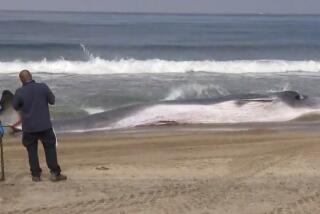When you know where to look, whales can be hard to miss
SANTA BARBARA SANTA BARBARA — It’s a bizarre yet wondrous sight: a 40-foot humpback whale holding position only a few feet beside a 75-foot catamaran.
The whale’s radiant white pectoral fins are spread like wings. Its massive body rolls gently as this great leviathan casts a curious glance toward its gawking admirers.
It’s one of two “friendlies” providing passengers aboard the Condor Express with encounters so close they can hardly believe their eyes.
“I would do this every day, in a heartbeat, if I could afford it,” says Ginny Harris, a tourist from Morehead City, N.C. “I live on the East Coast and we have dolphins, but I have never seen whales -- and certainly nothing like this.”
These are lively times in the Santa Barbara Channel. Vast blooms of krill and nutrient-rich waters teeming with bait fish have attracted dozens of mammalian species, including humpback and blue whales.
The high-speed Condor Express -- the only vessel making daily forays deep into the channel -- can reach the feeding grounds in less than an hour.
This voyage begins with a greeting from 300 common dolphins, who bow-ride momentarily, then peel away, one by one.
Up ahead is a 15-foot minke whale, which engages Capt. Dave Beezer in a brief game of cat-and-mouse.
The ocean is flat, and the air clear and warm. Santa Cruz and Santa Rosa Islands are wheat-colored and undeveloped, starkly contrasting with the cluttered mainland shore.
The captain is confident of finding humpbacks and hopeful of spying blues, although blue whales -- the planet’s largest creatures, reaching 100 feet and weighing up to 100 tons -- are just beginning to arrive.
Several minutes pass before Beezer scopes a large splash in the distance. Soon the vessel is alongside two humpbacks. Passengers crowd the rails and camera shutters click.
“I finally have proof!” shouts a gleeful Jeffrey Mummey, 11, from Heath, Ohio, explaining that his cousin Nick, who is not aboard, “never believes me when I tell him stuff.”
Globally, humpbacks number 35,000 to 40,000. The ones we see are among the perhaps 1,300 that migrate between Costa Rica and California. They can measure 40 to 50 feet and weigh about 40 tons.
This pair is interested only in feeding, though, so Beezer veers toward another pair, and the encounter is like that of two people on a blind date growing accustomed to each other and finally embracing.
The whales have mugged the vessel, generating oohs and aahs, followed by eews as plumes of fishy whale breath waft over the decks.
Photo cards are emptied and new ones hastily shoved into cameras, but the best pictures are stored in human memory.
Finally, Beezer notes the hour and begins to pull away. It’s a disappointing moment for the passengers, who, as the Condor Express picks up speed, gaze back to see both whales breaching and splashing down, as if to beckon the people back. Or say goodbye.
--
-- Pete.Thomas@latimes.com
--
WHALE WATCHING
WHERE: Aboard the Condor Express, which departs from Santa Barbara’s Sea Landing
WHEN: 10 a.m.-2:30 p.m. daily
PRICE: $94 adults, $50 children
INFO: (888) 779-4253; www.condorcruises.com
More to Read
Sign up for The Wild
We’ll help you find the best places to hike, bike and run, as well as the perfect silent spots for meditation and yoga.
You may occasionally receive promotional content from the Los Angeles Times.






